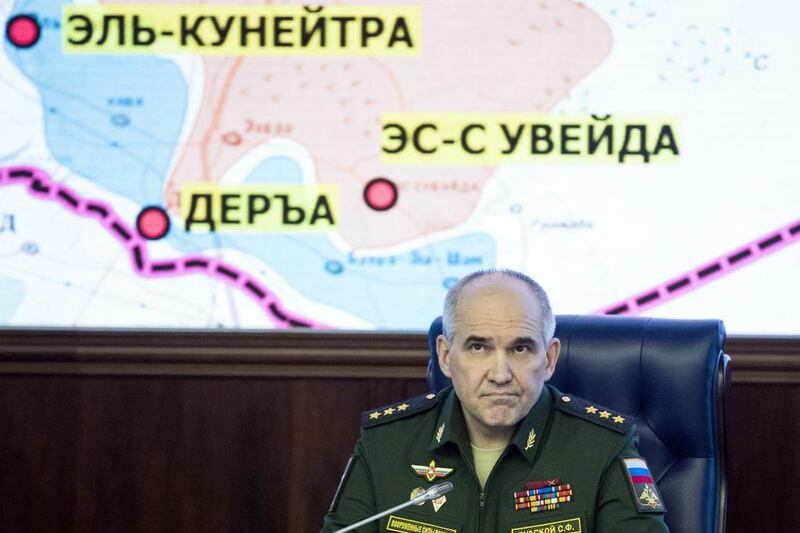BEIRUT // A deal signed by Russia, Iran and Turkey on Thursday appears to give Syria’s opposition something it has been requesting for a long time: internationally-backed safe zones for civilians. But the agreement is not exactly what it had in mind, and is already primed for failure.
The chief problems facing these proposed “de-escalation zones” are the same ones that undermined past agreements on cessation of hostilities: the Syrian government and its allies have a very loose definition of what constitutes a terrorist group and the presence of extremist groups that have a vested interest in spoiling the peace.
The latest agreement allows the Syrian government and its allies to continue fighting “terrorism” in the large areas encompassed by the deal. But to the Syrian regime, anybody who takes up arms against the rule of president Bashar Al Assad is a terrorist. This is the same loophole that allowed military operations to continue during numerous ceasefire pacts in Syria last year.
Even if the regime and its allies hold off on attacking rebel groups, the dominant presence of former Al Qaeda branch Jabhat Al Nusra, which now goes by the name Hayat Tahrir Al Sham, in the proposed safe zone areas is a threat to the agreement. The group has spoilt past ceasefire agreements and continues to have no interest in pursuing peace given that it is explicitly excluded from any potential political settlement to end the Syria’s six-year-old war. It will continue fighting the regime and will encourage allied rebel groups to do the same in any safe zone that is set up in areas under its control.
In theory, safe zones are meant to allow civilians a place of refuge, where aid organisations can help them without getting caught in attacks. If violence continues in rebel areas, even at a lower level, it will threaten both the safety of civilians and the delivery of aid to them.
For a safe zone to be truly effective, it should be free of the presence of armed factions that would give other sides a pretext for attacks. This easier for smaller areas that can more easily be cleared of armed groups and guarded by a neutral protection force. But the agreement hammered out in Astana on Thursday does the opposite – it delineates large chunks of rebel territory as safe zones, thereby guaranteeing the presence of armed factions and giving the Syrian government and its allies justification to attack if they wish.
Then there is the question of who will protect the safe zones. The three signatories and guarantors of the agreement, Iran, Russia and Turkey, are all active participants in the war. Iran and Russia are actively backing Damascus and Turkey is supporting proxy rebel militias in the north, though it has kept these groups from fighting against the government since last year.
None of these parties have the neutrality that would ideally be required for monitoring safe zones. In essence, the belligerents themselves will be tasked with upholding their commitments to the de-escalation agreement. And if Russian or Iranian forces are deployed to man checkpoints and operate in rebel-held areas, they are likely to be attacked by rebels, quickly undoing the agreement.
Russian officials said on Friday that other countries could participate in enforcing the zones, but did not say who those countries might be. They said the plan would go into effect at midnight on Friday but the proposed safe zones would take a month to establish.
Rebel factions, which have long called for safe zones and no-fly zones over their areas, were quick to denounce Thursday’s agreement. Osama Abu Zaid, an opposition delegate to the talks in the Kazakh capital Astana, said the agreement threatened Syria’s territorial integrity and that the rebels would never support an agreement that relied on Iran as a guarantor.
The US appeared uneasy with the deal, with the state department saying Washington welcomed efforts to reduce violence in Syria but did not trust Iran’s role in the agreement. “Iran’s activities in Syria have only contributed to the violence, not stopped it, and Iran’s unquestioning support for the Assad regime has perpetuated the misery of ordinary Syrians,” spokeswoman Heather Nauert said.
Moscow also said on Friday that American and anti-ISIL coalition planes would be barred from flying in the safe zones, but the Pentagon said its operations against the extremist group would not be affected.
The US president Donald Trump has repeatedly called for the creation of safe zones for civilians in Syria, saying the United States would get Arab Gulf states to pay for them. While the plan was raised several times before and after his inauguration in January, details on how and where such safe zones would be established were scant. Given the exclusion of the US from the latest agreement and its criticism of its framework, it can be assumed that it is not what Washington had in mind when Mr Trump floated the idea.
jwood@thenational.ae
* with additional reporting from Reuters and Associated Press





